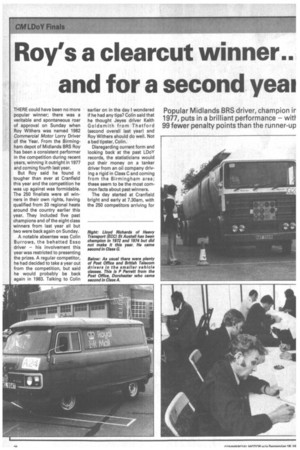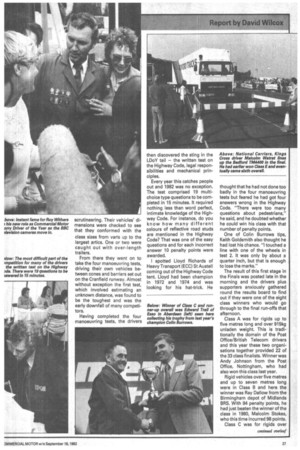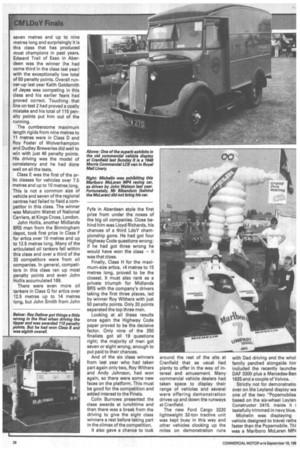Roy's a clearcut winner..
Page 22

Page 23

Page 24

Page 25

Page 26

If you've noticed an error in this article please click here to report it so we can fix it.
and for a second yea'
THERE could have been no more popular winner; there was a veritable and spontaneous roar of approval on Sunday when Roy Withers was named 1982 Commercial Motor Lorry Driver of the Year. From the Birmingham depot of Midlands BRS Roy has been a consistent performer in the competition during recent years, winning it outright in 1977 and coming fourth last year.
But Roy said he found it tougher than ever at Cranfield this year and the competition he was up against was formidable. The 250 finalists were all winners in their own rights, having qualified from 33 regional heats around the country earlier this year. They included five past champions and of the eight class winners from last year all but two were back again on Sunday.
A notable absentee was Colin Burrows, the behatted Esso driver — his involvement this year was restricted to presenting the prizes. A regular competitor, he had decided to take a year out from the competition, but said he would probably be back again in 1983. Talking to Colin earlier on in the day I wondered if he had any tips? Colin said that he thought Jeyes driver Keith Goldsmith from Thetford (second overall last year) and Roy Withers should do well. Not a bad tipster, Colin.
Disregarding current form and looking back at the past LDoY records, the statisticians would put their money on a tanker driver from an oil company driving a rigid in Class C and coming from the Birmingham area; these seem to be the most common facts about past winners.
The day started at Cranfield bright and early at 7.30am, with the 250 competitors arriving for scrutineering. Their vehicles' dimensions were checked to see that they conformed with the class sizes from vent up to the largest artics. One or two were caught out with over-length trailers.
From there they went on to take the four manoeuvring tests, driving their own vehicles between cones and barriers set out on the Cranfield runway. Almost without exception the first test, which involved estimating an unknown distance, was found to be the toughest and was the early downfall of many competitors.
Having completed the four manoeuvring tests, the drivers then discovered the sting in the LCloY tail — the written test on the Highway Code, legal responsibilities and mechanical principles.
Every year this catches people out and 1982 was no exception. The test comprised 19 multichoice type questions to be completed in 15 minutes. It required nothing less than word perfect, intimate knowledge of the Highway Code. For instance, do you know how many different colours of reflective road studs are mentioned in the Highway Code? That was one of the easy questions and for each incorrect answer 10 penalty points were awarded.
I spotted Lloyd Richards of Heavy Transport (ECC) St Austell coming out of the Highway Code tent. Lloyd had been champion in 1972 and 1974 and was looking for his hat-trick. He thought that he had not done too badly in the four manoeuvring tests but feared he had got four answers wrong in the Highway Code. "There were too many questions about pedestrians," he said, and he doubted whether he could win his class with that number of penalty points.
One of Colin Burrows tips, Keith Goldsmith also thought he had lost his chance. "I touched a line with one of the wheels in test 2. It was only by about a quarter inch, but that is enough to lose the marks."
The result of this first stage in the Finals was posted late in the morning and the drivers plus supporters anxiously gathered round the results board to find out if they were one of the eight class winners who would go through to the final run-offs that afternoon.
Class A was for rigicis up to five metres long and over 915kg unladen weight. This is traditionally the domain of the Post Office/British Telecom drivers and this year these two organisations together provided 22 of the 33 class finalists. Winner was Andy Johnson from the Post Office, Nottingham, who had also won this class last year.
Rigid vehicles over five metres and up to seven metres long were in Class B and here the winner was Ray Dallow from the Birmingham depot of Midlands BRS. With 94 penalty points, he had lust beaten the winner of the class in 1980, Malcolm Stokes, who this time incurred 98 points.
Class C was for rigids over seven metres and up to nine metres long and surprisingly it is this class that has produced most champions in past years. Edward Trail of Esso in Aberdeen was the winner (he had come third in the class last year) with the exceptionally low total of 50 penalty points. Overall runner-up last year Keith Goldsmith of Jeyes was competing in this class and his earlier fears had proved correct. Touching that line on test 2 had proved a costly mistake and his total of 115 penalty points put him out of the running.
The cumbersome maximum length rigids from nine metres to 11 metres were in Class D and Roy Foster of Wolverhampton and Dudley Breweries did well to win with just 46 penalty points. His driving was the model of consistency and he had done well on all the tests.
Class E was the first of the artic classes for vehicles over 7.5 metres and up to 10 metres long. This is not a common size of vehicle and seven of the regional centres had failed to field a competitor in this class. The winner was Malcolm Watret of National Carriers, at Kings Cross, London.
John Hollis, another Midlands BRS man from the Birmingham depot, took first prize in Class F for artics over 10 metres and up to 12.5 metres long. Many of the articulated oil tankers fell within this class and over a third of the 33 competitors were from oil companies. In general, competitors in this class ran up most penalty points and even John Hollis accumulated 169.
There were even more oil tankers in Class G for artics over 12.5 metres up to 14 metres long, but John Smith from John Fyfe in Aberdeen stole the first prize from under the noses of the big oil companies. Close behind him was Lloyd Richards, his chances of a third LdoY championship gone. He had got four Highway Code questions wrong; if he had got three wrong he would have won the class — it was that close.
Finally, Class H for the maximum-size artics, 14 metres to 15 metres long, proved to be the closest. It must also rank as a private triumph for Midlands BRS with the company's drivers taking the first three places, led by winner Roy Withers with just 50 penalty points. Only 20 points separated the top three men.
Looking at all these results once again the Highway Code paper proved to be the decisive factor. Only nine of the 250 finalists got all 19 questions right; the majority of men got seven or eight wrong, enough to put paid to their chances.
And of the six class winners from last year who had taken part again only two, Roy Withers and Andy Johnson, had won again, so there were some new faces on the platform. This must be good for the competition and added interest to the Finals.
Colin Burrows presented the class awards at lunchtime and then there was a break from the driving to give the eight class winners a rest before taking part in the climax of the competition.
It also gave a chance to look around the rest of the site at Cranfield that as usual had plenty to offer in the way of interest and amusement. Many commercial vehicle dealers had taken space to display their range of vehicles and several were offering demonstration drives up and down the runways at Cranfield.
The new Ford Cargo 3220 lightweight 32-ton tractive unit was kept busy in this way and other vehicles clocking up the miles on demonstration runs
with Dad driving and the whol family perched alongside hirr included the recently launche, DAF 3300 plus a Mercedes-Ben 1625 and a couple of Volvos.
Strictly not for demonstratio over on the Leyland display wa one of the two "Popemobiles based on the six-wheel Leylam Constructor 2415. Inside it i tastefully trimmed in navy blue.
Michelin was displaying vehicle designed to travel rathe faster than the Popemobile. Thi was a Marlboro McLaren N1N
by John Watson in last Formula 1 season and as closely examined by little Dys and their Dads alike.
For those who wanted to do )mething more energetic than and and stare there were enty of other activities. Karrier lotors was hosting a competi)n similar to television's iperstars and with the same rmmentator David Vine. This as drawing big crowds, all anxus to prove they could score a )ai, chip a golf ball and throw a riven aar's dart better than the rest.
On the far side of the Cranfield site, Scottish international darts player Jocky Wilson was taking on all corners on behalf of BRS. This was also a big attraction and I heard that Jocky did get beaten a few times although his throwing arm must have been sagging towards the end of the afternoon.
Sadly, the Bandag Bullet dragster lorry was not able to make a run as planned but was there on display. This version has a Ford Cargo cab in place of the previous Bullet's D-Series cab. Rebuilt by Dave Rackham of Auto Renovations, Strood, Kent, the new Bullet is still undergoing "shakedown" trials, but it is hoped that it should reach 200km/h (125mph) within a month or so. The previous Bullet clocked 173km/h (108mph). The Ford six-cylinder marine specification turbo engine has been further modified and develops 220kW (300bhp) at 3,400rprn.
There were 150 golden oldies on display, all courtesy of the Commercial Vehicle and Road Transport Club. It was difficult to pick out any individuals — all were fascinating — but particularly attractive was a 1946 Morris Commercial van, immaculate in Post Office colours.
In sharp contrast to this were Bedford's aerodynamic design projects which although they have been around for a few years now are still just as startling. One is based on the Bedford TM tractive unit while the other is the Aero, a distribution boxvan on a TL chassis.
Like an angry wasp swooping and climbing above Cranfield was an autogyro sponsored by Mercedes-Benz. This amazing little machine has only a pusher propellor — the forward motion gives the impetus to power the main lift rotor and the result is very agile, akin to a flying motorbike. Its pilot was from British Airways — Captain John Kitchin — who normally flies Tristars.
Halfway through the afternoon the serious matter of driving was the main attraction once more as the eight class winners prepared to do battle in the run-offs. The driving tests this time were completed in the same four vehicles, provided by Bedford. Each man had to drive each vehicle, thus proving his versatility as well as his skill.
It must be particularly nervewracking for the winners of the smaller classes; when you normally drive a van it is quite a step up into an artic, especially when several thousand people are watching you reverse between some cones. In these tests just touching a cone, a barrier or a painted line incurred 50 penalty points and the competitors were not allowed to accrue more than 100 points.
Test 1 was taken in a Bedford CF350 van and despite its small size this proved to be the most difficult. The competitors were asked to drive into and reverse out of a simulated parking gap, getting as close to the barriers and kerb as possible without touching them. Eager marshals waving measuring sticks carefully checked how far they were from the kerb and barriers. All eight finalists did a superb manoeuvre — but all eight incurred 100 penalty points. Was it possible they asked?
On to Test 2 and into a Bedford TL1260 with a dropside body. After driving between some offset cones the competitors had to stop the vehicle with its nearside front wheel posi-tioned on a painted target and then reverse into a painted garage with tapering sides; if they went in too far they went over the lines. All eight men found this a little easier than the first test.
A Bedford TM2600 six-wheel tipper was used for Test 3. More cones, more reversing and if they were not careful more pen alty points. Sadly, Ray Da!low of Midlands BRS misunderstood the instructions and went a little wrong, which automatically meant 110 penalty points which put him out of the running.
Roy Withers and Roy Foster did particularly well in the tipper. John Hollis stopped the vehicle beautifully with the front wheels in the appropriate painted box, but had collected a cone under the front bumper earlier in the test, which ruined his chances.
The last test was in a Bedford TM4400 tractive unit pulling a 12.2-metre (40ft) Crane Fruehauf dry-freight boxvan. This test was simple to understand but difficult to do and involved driving forward into a very tight garage made out of barriers, reversing out and then driving forward to park alongside a painted line on the nearside.
Roy Withers did well at this and John Hollis made amends by also doing rather better. John Smith touched a barrier in the garage with the artic which lost him a couple of places.
It was all over and within half an hour the points had been added up and the eight men were sitting nervously on the stage. A whole list of ancillary awards were made first. Regrettably, the award for the Best Lady Driver remained unpresented because no lady drivers had won through to the Finals. Maybe next year.
Coming to the main awards,in fourth place with 362 points was Andy Johnson of the Post Office. A fine effort for a man who usually drives a van and an improvement on his final placing last year.
Third with 311 points was Roy Foster from Wolverhampton and Dudley Breweries. He had plenty of supporters with him and was a popular competitor. Runner-up was Edward Trail, who had made the long journey down from Esso in Aberdeen. He had 298 penalty points.
Which left Roy Withers top of the pile with a miserly 199 penalty points, a clear-cut winner. As he fought his way down off the stage, he was swamped, but his wife got there first with a kiss. She narrowly beat the local radio station who had just discovered lorry drivers for the first time and none other than the BBC who had been filming the afternoon for its Top Gear motoring programme.
Roy told me that in his everyday job with Midlands BRS at Birmingham he drives a Ford Transcontinental tractive unit. He thought that the LDoY competition was getting harder each year.
Roy was one of the nine drivers to get a clean sheet in the Highway Code test, but commented: "The questions get more devious every year." In the final run-off he, too, had found the first manoeuvring test in t Bedford CF van to be the mc difficult; it really was very tig indeed.
With three of the eight cla winners, the overall champii and total dominance of class Midlands BRS must share t headlines with Roy Withers. asked Roy: how did they ma age it? "I think you have got put it down to a good trainit school," he said. If that is tn then Midlands BRS certain reaped the rich rewards lz week. And those statisticia will note that it also adds to t growing list of Birminghal based champions.
In addition to the trophi( cheques and prizes he won, R Withers can also look forward the Michelin European stu, award which this year is a we long trip to Sweden where I will be sure to experience sor really different driving con' tions — the worst that a Swedi winter can throw at him.
If he handles the ice and snc as well as he tackled the cones Cranfield last Sunday, it will la( pleasure to watch.
• Photos by Les Davis














































